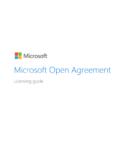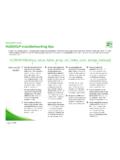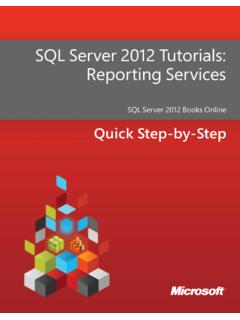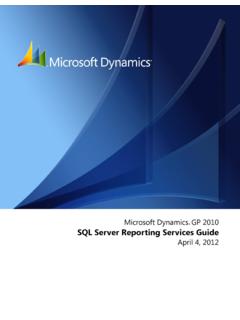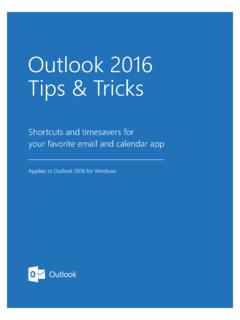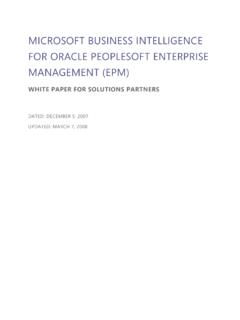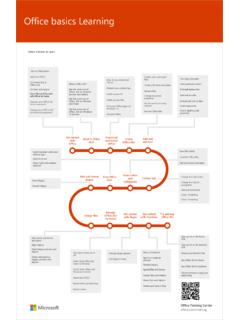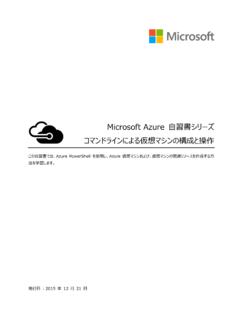Transcription of 70-486: Developing ASP.NET MVC Web Applications
1 70-486: Developing MVC Web Applications Candidates for this exam are professional developers who use microsoft Visual Studio 20120157 and microsoft .NET. to design and develop web solutions. Candidates should have a minimum of three to five years of experience Developing microsoft MVC based solutions and knowledge of microsoft Azure Web Apps. Candidates should also have the following experience: Designing and Developing web Applications in an MVC model Planning and designing user interaction solutions based on business requirements Experience with the full software development life cycle of web Applications Developing and deploying to multi-tier environments, including Azure Designing and Developing asynchronous solutions Objective Domain Note: This document shows tracked changes that are effective as of January 15, 2018. Design the application architecture (15-20%).
2 Plan the application layers Plan data access; plan for separation of concerns,; appropriate use of models, views, controllers, view components, and view service dependency injection; choose between client-side and server-side processing;. design for scalability; ; choose between Core and ; choose when to use .NET standard libraries; understand differences between DNX and DNX core Design a distributed application Design a hybrid application; plan for session management in a distributed environment; plan web farms; run microsoft Azure services on-premises with Azure Pack; enable deferred processing through Azure features (including queues, scheduled, and and on-demand jobs, Azure Functions, and Azure Web Jobs, etc.).). Design and implement the Azure Web Apps life cycle Identify and implement Start, Run, and Stop events are triggered; code against application events in your Applications ; identify configure startup tasks, including (IIS, app pool configuration, and [app pool], third- party tools).
3 Configure state management Choose a state management mechanism including (in-process and , out of process, and Redis- based state management); plan for scalability; use cookies or local storage to maintain state; apply configuration settings in files; implement sessionless state (including for example, Qquery sStrings;), configure middleware to enable session and application state in Core). Design a caching strategy. Implement page output and donut caching (performance oriented)caching and; implement data caching;. create cache profiles; implement HTTP caching; implement Azure Redis caching; plan a content delivery network (CDN) strategy, for example, Azure CDN. Design and implement a Web Socket strategy Read and write string and binary data asynchronously; choose a connection loss strategy; decide when to use Web Sockets; implement SignalR; enable web socket features in an Azure Web App instance Design HTTP modules and handlers Implement synchronous and asynchronous modules and handlers, choose between modules and handlers in IIS.
4 Design a configuration management solution Manage configuration sources, including XML, JSON, and INI files; manage environment variables; implement Option objects; implement multiple environments using files and hierarchical structure; manage sensitive configuration; react to runtime configuration changes; implement a custom configuration source; secure configuration by using Azure Key Vault; use the Secret Manager tool in development to keep secrets out of your code for configuration values Interact with the host environment Work with file system using file providers; work with environment variables; determine hosting environment capabilities; implement native components, including PInvoke and native dependencies for hosts including Linux and Windows; use hosting on an Open Web Interface for .NET (OWIN)-based server Compose an application by using the framework pipeline Add custom request processing modules to the pipeline; add, remove, and configure services used in the application; design and implement middleware; design for kestrel, web server and IIS; design and implement startup filters Design the build and deployment architecture (10-15%).
5 Design a browser artifact build strategy Design a JavaScript build pipeline using Gulp, Grunt, npm and Bower; design an artifact build strategy using Less, Sass and Font Awesome; design and implement a bundling and minification strategy for broswer artifacts, including JavaScript, CSS and images Design a server build strategy Manage NuGet dependencies; target runtimes, including the full .NET Framework, .NET core, and .NET. standard; manage debug and release configurations, including compilation and optimization options; include or exclude files from build; manage build sources, including content, resources, and shared files; implement metadata for projects, including version, release notes, and descriptions; define other build options, including xmlDoc and warningsAsErrors; work with static files in core Design a publishing strategy Implement application publishing using ; manage publishing options in csproj; implement additional tooling; implement pre-publish and post-publish scripts; implement native compilation; publish to Docker container image Implement an Azure deployment strategy Deploy Azure Web App using supported deployment models including FTP, Kudu, Web Deploy, and Visual Studio Publishing Wizard; provision ARM- based resources while deploying Applications .
6 Implement deployment environments, including dev, test, and prod in Azure; use deployment slots for staging sites;. deploy to Azure Stack Implement a on-premises deployment strategy Deploy application to IIS using Web Deploy, xcopy, and Visual Studio Publishing Wizard; deploy application to Windows Nano Server, deploy application to IIS Hosted Web Core, deploy application to web server;. deploy application to Kestrel on Windows and Linux; implement reverse proxying to Kestrel using IIS and Nginx Design the User Experience (2015-2520%). Create elements of the user interface for a web application Create and apply styles by using CSS; structure and lay out the user interface by using HTML, including HTML5; implement dynamic page content based on a design; use client framework package management;. leverage CSS processors to simplify application style maintenance Design and implement UI behavior Implement client-side forms validation; use JavaScript to manipulate the DOM; extend objects by using prototypal inheritance; use AJAX to make partial page updates; implement the UI by using JQuery Compose Design the UI layout of an application Implement partial views and view components for reuse in different areas of the application; design and implement pages by using Razor syntaxPages; design and implement layouts to provide visual structure.
7 Define and render optional and required page sections; create and use tag and HTML helpers to simplify markup Enhance application behavior and style based on browser feature detection Detect browser features and capabilities; create a web application that runs across multiple browsers and mobile devices; enhance application behavior and style by using vendor-specific extensions, for example, CSS. Plan an adaptive UI layout Plan for running Applications in browsers on multiple devices (screen resolution, CSS, HTML), plan for mobile web Applications Plan a responsive UI layout Plan for Applications that run on multiple devices and screen resolutions; use media queries and Bootstrap's responsive grid; detect browser features and capabilities; create a web application that runs across multiple browsers and mobile devices; enable consistent cross-browser experiences with polyfills Plan mobile UI strategy Implement mobile specific UI elements such as touch input, low bandwidth situations, and device oritentation changes; define and implement a strategy for working with mobile browsers Develop the User Experience (15-20%).
8 Plan for search engine optimization and accessibility Use analytical tools to parse HTML; provide an xml sitemap and file to improve scraping; write semantic markup for accessibility, for example, screen readers; use rich snippets to increase content visibility Plan and implement globalization and localization Plan a localization strategy; create and apply resources to UI including JavaScript resources; set cultures;. implement server side localization and globalization create satellite resource assemblies Design and implement MVC controllers and actions Apply authorization attributes, global filters ( , including global, , and authentication, and overriddable filters); specify an override filter; use choose and implement custom HTTP codesstatus codes and responses;. implement action results; implement MVC areas; implement Dependency Injection for services in controllers.
9 Implement model and property binding; use best practices in model binding Design and implement routes Define a route to handle a URL pattern; apply route constraints; ignore URL patterns; add custom route parameters; define areas; define routes that interoperate with Single Page Application frameworks such as Angular;. Control application behavior by using MVC extensibility points `. Create custom middleware and inject it into the pipeline; implement MVC filters and controller factories;. control application behavior by using action results, model binders, and route handlers; inject services into a view Reduce network bandwidth Bundle and minify scripts (CSS and JavaScript); compress and decompress data (using gzip/deflate; storage);. plan a content delivery network (CDN) strategy, for example, Azure CDN. Design and implement serialization and model binding Serialize models and data using supported serialization formats, including JSON, XML, protobuf, and WCF/SOAP; implement model and property binding, including custom binding and model validation.
10 Implement web socket communication in MVC; implement file uploading and multipart data; use AutoRest to build clients Troubleshoot and Debug Web Applications (20-25%). Prevent and troubleshoot runtime issues Troubleshoot performance, security, and errors;. implement tracing, logging, and debugging (iincluding IntelliTrace); enable and configure health monitoring (including Performance Monitor)); configure and use App Insights runtime telemetry Design an exception handling strategy Handle exceptions across multiple layers; use MVC middleware to configure error handling; use different exception handling strategies for different environments; create and display custom error pages; configure a custom pipeline for error handling; handle first chance exceptions; configure and use App Insights; log application exceptions;. Test a web application Create and run unit tests, for example, use the Assert class, create mocks and stubs; create and run web tests including using Browser Link; debug a web application in multiple browsers and mobile emulators; use Azure DevTest Labs; use Visual Studio Team Services Debug an Azure application Collect diagnostic information by using Azure App Insights; choose log types, for example, event logs, performance counters, and crash dumps; stream logs directly to Visual Studio from a deployed site; debug an Azure application by using Visual Studio andStudioand remote debugging; interact directly with remote Azure websites using Server Explorer Design and Implement Security (2015-2520%).
